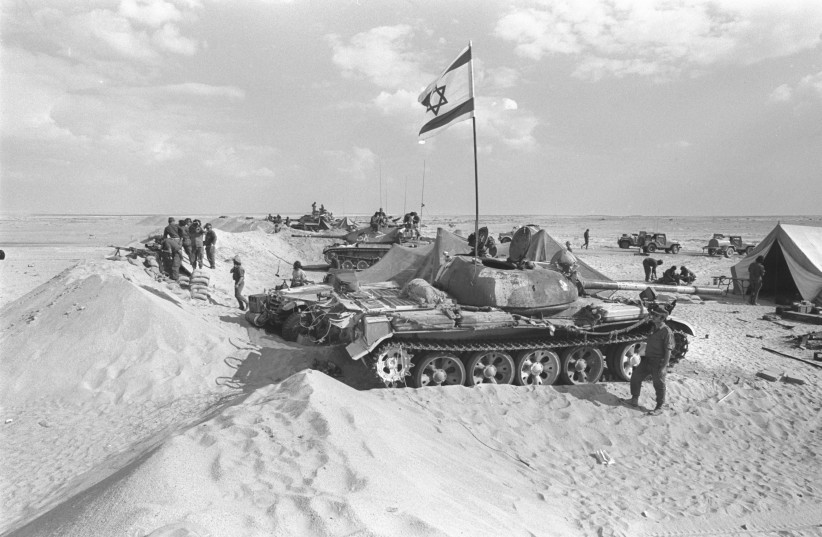Therapy has never been more collective, nostalgic, and healing.
Recalling the war that raged 50 years ago this month and shook Israel to its foundation, a plethora of cinematic dramas, TV documentaries, radio programs, and newspaper features have reopened, and often rewritten, the Yom Kippur War’s military episodes, political backdrop, and personal tragedies.
Golda Meir, for instance, widely vilified over the decades for having failed to prevent the Egyptian-Syrian surprise attack, emerges largely rehabilitated from director Guy Nattiv’s Golda, starring Helen Mirren in what Jerusalem Post film critic Hannah Brown called a “touching performance” worthy of an Oscar nomination.
Journalist Sima Kadmon’s TV documentary The One demystifies the Israel Air Force by visiting Unit 201 whose casualties – seven pilots and navigators killed, and 15 who fell captive – were the highest any Israeli squadron suffered in any of Israel’s multiple wars.
Turning to the ground war, director Lior Chefetz’s The Stronghold enacts the battle of the southernmost of Israel’s 16 outposts along the Suez Canal, (“The Pier”), where 42 warriors endured the onslaught of Egyptian artillery and commandos for eight days before compelled to surrender in the face of dwindling supplies and mounting casualties – 21 severely wounded and five dead.

The birth of Israel's first currency
The dilemmas of the outpost’s commander, a 21-year-old child of Holocaust survivors who faces the outpost’s doctor, a 29-year-old surgeon, encapsulate the clash between Israeli military values, which discourage surrender, and the medical ethic of preserving human life.
The common denominator between these artistic retrospections is a renewed search after a pivotal war’s direct victims. However, the Yom Kippur War also had indirect victims, most of them unsung and improbable, and some actually big; unsung as the lira, improbable as the kibbutz, and as big as the Soviet Union.
THE LIRA, Israel’s original currency, was born haphazardly.
Faced with Britain’s removal of Palestine from its “Sterling Area,” Israel was forced to create a currency while fighting its War of Independence – unlike, for instance, the US, whose Coinage Act, national mint, and silver dollar were born 16 years after the American Declaration of Independence.
With a shipment of eight million American-printed bills landing in the wheat fields of Kibbutz Ein Shemer in July 1948, the young state’s citizens were asked to go to the banks and convert their Palestinian pounds into Israeli liras. It took several months, but the process passed smoothly in what amounted to a vote of confidence for the new currency.
The lira then proceeded to linchpin what will be one of the postwar world’s most vibrant economies, opening new factories routinely, and growing annually by some 10%. Though devalued several times over the years, the lira seemed even more solid after the 1967 Six Day War, as victory’s optimism was coupled with new immigration from the rich, developed world and the deployment of cheap Palestinian labor.
The Yom Kippur War brought all this to an abrupt end. With defense spending soaring by 1975 to 31% of the gross national product, deficits ballooned, inflation spiked, and the lira became paper money. The lira’s formal death would be announced only in 1980, with the launch of the shekel, but what killed the first Israeli currency was the Yom Kippur War.
A similar thing happened to the kibbutz.
Yes, the kibbutz is nominally alive and well – in fact, there are 265 of them; but they are no longer what they once were. No, it’s not that the kibbutzim are no longer the famously egalitarian communities they once were, as 80% of them are by now privatized. It’s that the kibbutz is no longer the mass-producer of leaders it once was.
Of Israel’s 24,213 fallen soldiers 3,111 were kibbutzniks. In one single 1967 Air Force aviators’ course, 23 of 32 graduates were kibbutzniks.
Of the Yom Kippur War’s 2,600 fallen soldiers, 470 were kibbutz members, nearly one-fifth of the fatalities and nine times the kibbutzniks’ share of the overall population at the time. The kibbutzniks’ share among the officers was even higher. One kibbutz, Beit Hashita, lost 11 men.
The kibbutzim never filled the leadership vacuum with which they emerged from the Yom Kippur War. Joining the general economic crisis that the war spawned, 135 kibbutzim sank into a huge debt crisis that resulted in privatizations that discolored the original kibbutz.
Yes, the kibbutz survived; but in the Yom Kippur War, it lost its soul.
The war’s blow to the USSR was even worse.
THE SUPERPOWER that Ronald Reagan would later call The Evil Empire was the Arab assault’s engine, compass, and fuel tank. The Soviets agitated its leaders, supplied its arms, trained its commanders, and oversaw its plan.
While at it, the Soviets also obstructed two million Jews’ freedoms of movement, association, occupation, and worship.
That’s what happened out there. Back here, in the killing fields of the Sinai desert and the Golan Heights, Soviet-made arms were crushed by Western-made arms, thus dealing the USSR’s elaborate arms industry a reputational blow from which it never recovered.
Worse, the war ended with Moscow’s biggest Arab client, Egypt, defecting from Soviet tutelage to Uncle Sam’s fold. Worst of all, Uncle Sam used his new regional clout to strike peace between its new ally and the Jewish state.
Across the East Bloc, thousands of party leaders, ministers, governors, mayors, diplomats, academics, and literati pieced all this together and lost faith in their empire’s power and ideology. A mere decade after Camp David the Berlin Wall collapsed and soon afterward the Soviet Union fell apart.
Yes, the morning after the Middle Eastern Armageddon that it concocted, the Soviet Union was still intact. Its soul, however, like those of 2,600 Israeli soldiers and at least 8,000 Arab troops, died in the Yom Kippur War.
www.MiddleIsrael.net
The writer, a Hartman Institute fellow, is the author of the bestselling Mitzad Ha’ivelet Ha’yehudi (The Jewish March of Folly, Yediot Sefarim, 2019), a revisionist history of the Jewish people’s political leadership.
